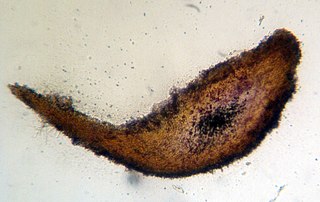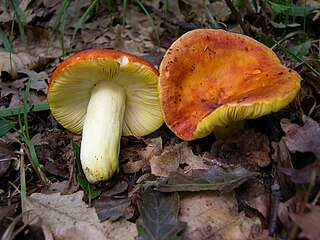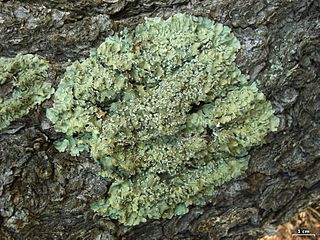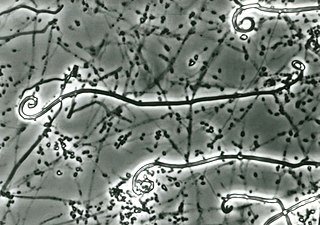Related Research Articles

The Hymenochaetales are an order of fungi in the class Agaricomycetes. The order in its current sense is based on molecular research and not on any unifying morphological characteristics. According to one 2008 estimate, the Hymenochaetales contain around 600 species worldwide, mostly corticioid fungi and poroid fungi, but also including several clavarioid fungi and agarics. Species of economic importance include wood decay fungi in the genera Phellinus and Inonotus sensu lato, some of which may cause losses in forestry. Therapeutic properties are claimed for Inonotus obliquus ("chaga") and Phellinus linteus, both of which are now commercially marketed.

Melzer's reagent is a chemical reagent used by mycologists to assist with the identification of fungi, and by phytopathologists for fungi that are plant pathogens.

Pluteus is a large genus of fungi with over 300 species. They are wood rotting saprobes with pink spore prints and gills that are free from the stem.
Gastón Guzmán Huerta, a Mexican mycologist and anthropologist, was an authority on the genus Psilocybe.

Peziza is a large genus of saprophytic cup fungi that grow on the ground, rotting wood, or dung. Most members of this genus are of unknown edibility and are difficult to identify as separate species without use of microscopy. The polyphyletic genus has been estimated to contain over 100 species.
Acarosporina microspora is a species of fungus in the family Stictidaceae. A plant pathogen, it causes a condition in elms known as Schizoxylon canker. It was originally described in 1938 under the name Schizoxylon microsporum.
Cantharellopsis is a tan- to whitish-colored bryophilous monotypic genus in the Hymenochaetales. The fruit bodies of the single species Cantharellopsis prescotii has a form intermediate between an Omphalina and a chanterelle (Cantharellus) because of its forked, fold-like gills. It inhabits moss on calcareous soils in temperate regions of Europe. Phylogenetically related agarics are in the genera Contumyces, Gyroflexus, Loreleia, Rickenella and Blasiphalia, as well as the stipitate-stereoid genera Muscinupta and Cotylidia and the clavarioid genus, Alloclavaria.

Russula aurea, commonly known as the gilded brittlegill, is an uncommon species of mushroom found in deciduous woodland in Europe in summer and early autumn. Unlike many red-capped members of the genus, it is edible and mild-tasting.
Candelabrochaete is a genus of crust fungi in the family Phanerochaetaceae.

Flavopunctelia is a genus of foliose lichens in the family Parmeliaceae. The genus contains species that are widespread in temperate and tropical areas. The genus is characterised by broad, yellow-green lobes, point-like (punctiform) pseudocyphellae on the thallus surface, and bifusiform conidia. All species contain usnic acid as a major secondary chemical in the cortex. Flavopunctelia was originally conceived as a subgenus of Punctelia by Hildur Krog in 1982; Mason Hale promoted it to generic status in 1984.
Platypeltella is a genus of fungi in the family Microthyriaceae. The genus was circumscribed by Austrian-Czech mycologist Franz Petrak in 1929, with Platypeltella smilacis as the type and only species. Platypeltella remained monotypic until P. angustispora was added in 1969. A third species, P. irregularis, was described in 1982. All species grow as plant pathogens on monocot hosts.

Neobulgaria is a genus of fungi within the family Leotiaceae. The genus, circumscribed by the Austrian mycologist Franz Petrak in 1921, contains nine species.
The Lahmiales are an order of fungi in the Ascomycota, or sac fungi. The order has not been assigned to any class. The taxon is monotypic and contains a single family, the Lahmiaceae, which in turn contains the single genus Lahmia.
Calathella is a genus of fungi in the mushroom family Marasmiaceae. According to the Dictionary of the Fungi, the genus contains nine species found in Europe and North America. The genus was circumscribed by the English mycologist Derek Reid in 1964.

Uncinocarpus is a genus of fungi within the Onygenaceae family. The name is derived from the Latin word uncinus, meaning "hook" and the Greek word karpos (καρπός), meaning "fruit". It was distinguished from the genus Gymnoascus based on keratinolytic capacity, ascospore morphology and the development of hooked, occasionally spiraling appendages. Alternatively, Uncinocarpus species may possess helically coiled or smooth, wavy appendages, or lack appendages altogether, an example of such species being U. orissi.
Arachniotus is a genus of fungi within the family Gymnoascaceae.

Tuber is a genus in the Tuberaceae family of fungi, with estimated molecular dating to the end of the Jurassic period. It includes several species of truffles that are highly valued as delicacies.
Richard Paul "Dick" Korf was an American mycologist and founding co-editor of the journal Mycotaxon. He was a preeminent figure in the study of discomycetes and made significant contributions to the field of fungal nomenclature and taxonomy. Korf was professor emeritus of mycology at Cornell University and director emeritus of Cornell University's Plant Pathology Herbarium.
References
- ↑ Sherwood MA. (1977). "The Ostropalean fungi". Mycotaxon. 5 (1): 1–277 (see p. 33).
- ↑ Johnston PR. (1985). "Anamorphs of the Ostropalean genera Schizoxylon and Acarosporina". Mycotaxon. 24: 329–60.
- ↑ Lumbsch TH, Huhndorf SM (December 2007). "Outline of Ascomycota – 2007". Myconet. Chicago, USA: The Field Museum, Department of Botany. 13: 1–58. Archived from the original on 2009-03-18.
- ↑ Kirk PM, Cannon PF, Minter DW, Stalpers JA (2008). Dictionary of the Fungi (10th ed.). Wallingford, UK: CABI. p. 4. ISBN 978-0-85199-826-8.